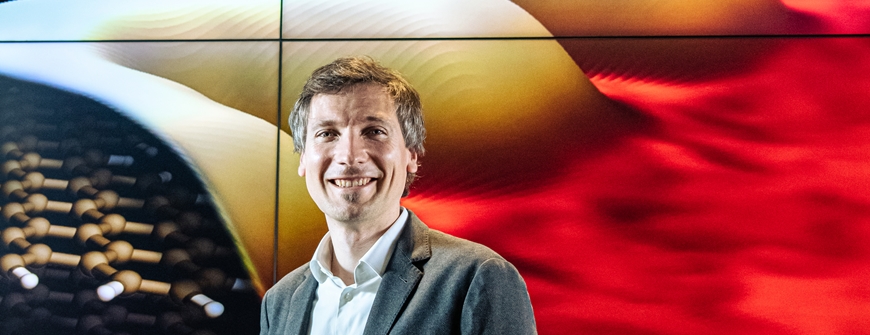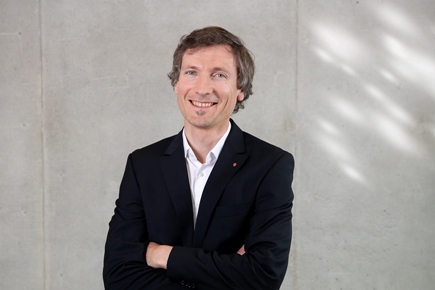Empa's research in space
“We need a certain critical mass”
From environmental monitoring to future moon bases: Innovative materials, processes, and models are essential for space travel. Lorenz Herrmann, member of Empa's Directorate and Head of the Advanced Materials and Surfaces department, explains how Empa's strengths can benefit the Swiss space industry and why collaborative networks remain key.

What is Empa, a materials research institute, doing in space?
Firstly, we have long been leaders in environmental modeling and analysis. In other words, we combine the observation, measurement and analysis of certain gases from space, such as greenhouse gases or air pollutants, with highly sensitive environmental analysis and atmospheric modeling.
And secondly, Empa naturally stands for novel materials and innovative production technologies – in this context, for the application field of space equipment, such as satellites, components for space stations, and research equipment for scientific missions. And all of this must, of course, function maintenance-free under extreme conditions for years on end. This would simply be unthinkable without an enormous expertise in materials science.
Linked to this, but going a step further, so to speak, is materials science and development in zero gravity, i.e., on the International Space Station (ISS) or in the context of parabolic flights. This is very fundamental but has always been a core area of Empa's work.
And last but not least, a look into the future: so-called in-space manufacturing, i.e., the idea of providing production capacities in space with the hope of being able to produce completely different materials with specific structures and unique properties under these very special conditions in space, for example for quantum computers or chip manufacturing.
And perhaps another step ahead: Space agencies are once again pursuing the vision of building a station on the moon. To do this, you have to use what is available up there. And, of course, this requires an extremely circular approach – precisely a field of research that Empa is currently advancing in our NEST building laboratory, for instance. That would then be circular construction on an entirely different level.
As you can see, there are quite a few points of contact …

“Space technologies” is a broad field. Where specifically can Empa's research make a difference?
First and foremost, of course, through our enormous expertise in materials, as already mentioned, but also because at Empa, we have a very thorough understanding of technology transfer, i.e., how to translate the latest scientific findings into practical applications. Take in-space manufacturing, for example: As soon as the first ideas for specific applications are available, we could develop appropriate materials and production processes that work under these very special conditions.
Empa has been a member of the Center for Space and Aviation Switzerland and Liechtenstein (CSA) since June. What do you expect from this partnership?
Our primary goal is to gain access to this new market – space technologies and applications. Swiss companies will be developing numerous new products and applications in this area in future, and at Empa we want to be part of this alliance. And then, of course, a certain visibility vis-à-vis the “big players” in the field, ESA and NASA. This requires a certain critical mass, which we hope to achieve through this partnership. Another advantage for us is the proximity to the innovation park just around the corner here in Dübendorf.
Lorenz Herrmann

Lorenz Herrmann studied and completed his doctorate in physics at the University of Regensburg and the Ecole Normale Supérieure in Paris.
In 2010, he joined the ABB Research Center in Dättwil, where he most recently headed the Energy Technologies department.
Since August 2022, he has headed the Empa department “Modern Materials and Surfaces”, and since January 2023 he has also been head of the research focus “Nanoscale Materials and Technologies”.
Good point: At the end of July, CSA, Switzerland Innovation, and Space Florida agreed to establish a joint hub for research and innovation in the field of space technology at the Innovation Park. There seems to be a kind of gold rush atmosphere when it comes to space at the moment ...
That's definitely the case, particularly in the field of satellite-based communication technologies. This area will become even more important globally in the future than it already is, especially since it is also of geostrategic significance. We will almost certainly see growth and a corresponding boom in this area in the future. What will also continue – probably on the same scale as today – are scientific space missions for Earth and space observation. These are enormously important for better understanding climate phenomena, for example. As for the more visionary areas, we are still looking for real “killer applications.” We will definitely continue to follow this closely.
How is the collaboration with the “big players,” such as ESA?
We are involved in numerous ESA projects through our long-standing partnership with the University of Bern (see graphic below). Since May, there has been another connection via the new European Space Deep-Tech Innovation Center Switzerland (ESDI), which was opened by ESA in collaboration with the Paul Scherrer Institute (PSI) at Park Innovaare and on whose advisory board I am. The aim here is to strengthen our research collaboration with ESA.
Empa technology in space: From Dübendorf ad astra
Dr. Lorenz Herrmann
Advanced Materials and Surfaces
Phone +41 58 765 6641
Space technologies
Empa's research is conquering space. From components for space probes and imaging techniques for satellites to materials development on the International Space Station: Empa researchers are working on a wide range of materials and technologies for use at the “final frontier”. But no matter how high the research flies, it is still down-to-earth, as technologies for space have a variety of applications on Earth, whether for innovative electronics, medical devices, or monitoring environmental agreements.
Read the EmpaQuarterly online or download the PDF version.
-
Share






